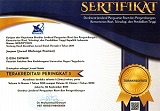Pengembangan rocking bike untuk mengoptimalkan keseimbangan tubuh pada anak usia dini
DOI:
https://doi.org/10.21831/jorpres.v17i2.40410Keywords:
Rocking Bike, Keseimbangan Tubuh, Anak Usia DiniAbstract
Penelitian ini bertujuan mengembangkan alat berupa rocking bike untuk mengoptimalkan keseimbangan tubuh pada anak usia dini sebagai alat bantu latihan yang dapat memberikan keefektifan. Metode penelitian menggunakan Research and Development (R&D) dengan 8 tahapan, yaitu identifikasi potensi dan masalah, pengumpulan informasi, desain produk, pembuatan produk, validasi ahli, revisi produk, uji coba, produksi akhir. Teknik analisis data penelitian berbentuk deskriptif kualitatif dan kuantitatif yang di olah dengan menggunakan rumus presentase. Hasil penelitian menunjukkan kelayakan pengembangan rocking bike untuk mengoptimalkan keseimbangan tubuh pada anak usia dini dengan validasi ahli materi satu (87,5%), ahli materi dua (95,8%), ahli media satu (97,5%), ahli media dua (87,9%), uji coba lapangan dari segi materi (87,7%), dari segi desain alat (93,0%), dari segi materi dan alat dengan total (90,4%). Kesimpulan rocking bike dinyatakan layak digunakan sebagai alat bantu latihan untuk mengoptimalkan keseimbangan tubuh pada anak usia dini.
DEVELOPMENT OF ROCKING BIKE FOR OPTIMIZING THE BODY BALANCE IN EARLY CHILDHOOD
Abstract
This research aims to develop a tool in the form of a rocking bike to optimize the body balance in early childhood as a training aid that can provide effectiveness. The research method used Research and Development (R&D). The research steps were taken from Sugiyono's research consisted of 10 steps, the researcher only took a few steps: identification of potentials and problems, gathering information, product design, product manufacturing, expert validation, product revision, testing, final production. The data analysis used descriptive qualitative and quantitative techniques in the form of percentaes. The results show the feasibility of developing the rocking bike to optimize body balance in early childhood with the validation of material expert 1 at (87.5%), material expert 2 at (95.8%), media expert 1 at (97.5%), media expert 2 at (87.9%), field trials in terms of material at (87.7%), in terms of tool design at (93.0%), in terms of materials and tools with a total (90.4%). These results indicate that the rocking bikes can be used as an exercise assistance to optimize the body balance in early childhood.
References
Al Anshori, Rosyid Fachrudin and , Prof. Dr. Kumaidi, MA (2017) Komunitas Sepeda Gowes Menjadi Gaya Hidup Sehat(Pada Komunitas Sepeda Gowes Rumah Sakit Soeradji Tirtonegoro Klaten Atau Scck). Skripsi thesis, Universitas Muhammadiyah Surakarta.
Arikunto, Suharsimi. (2002). Prosedur Penelitian: Suatu Pendekatan praktek. Jakarta: RinekaCipta.
DP, A. M., Indrayani, N. L. K., & NK, K. D. (2016). Optimalisasi Kelenturan (Flexibelity), Keseimbangan (Balance), dan Kekuatan (Strength) Tubuh Manusia Secara Instan dengan Menggunakan "Secret Method"*. VIRGIN: Jurnal Ilmiah Kesehatan Dan Sains, 1(1).
Harsono. (2001). Latihan Kondisi Fisik. Bandung: Senerai Pustaka.
Fatmawati, Fitri Ayu. 2020. Pengembangan Fisik Motorik Anak Usia Dini. Gresik: Caremedia Communication.
Sugiyono. (2012). Metode Penelitian Pendidikan : Pendekatan Kuantitatif, Kualitatif, dan R&D. Bandung: Alfabeta.
Sugiyono. (2013). Metode Penelitian Kuantitatif, Kualiatif dan R&D. Bandung: Alfabeta. Cv
Sugiyono. (2015). Metode Penelitian dan Pengembangan. Bandung: Alfabeta.
Sugiyono. (2016). Metode Penelitian Kuantitatif, Kualitatif, dan R&D. Bandung: Alfabeta.
Suharjana. (2013). Kebugaran Jasmani. Yogyakarta: Jogja Global Media.
Sumarno, A. (2012). Perbedaan penelitian dan Pengembangan. Elearning: UNESA.
Downloads
Published
How to Cite
Issue
Section
License
Authors who publish with this journal agree to the following terms:
- Authors retain copyright and grant the journal right of first publication with the work simultaneously licensed under a Creative Commons Attribution License that allows others to share the work with an acknowledgement of the work's authorship and initial publication in this journal.
- Authors are able to enter into separate, additional contractual arrangements for the non-exclusive distribution of the journal's published version of the work (e.g., post it to an institutional repository or publish it in a book), with an acknowledgement of its initial publication in this journal.
- Authors are permitted and encouraged to post their work online (e.g., in institutional repositories or on their website) prior to and during the submission process, as it can lead to productive exchanges, as well as earlier and greater citation of published work (See The Effect of Open Access).




